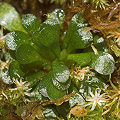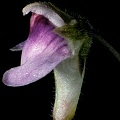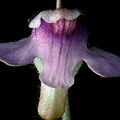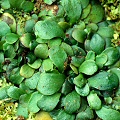| Species of Africa and Madagascar | |
|---|---|
| Subgenus Genlisea section Africanae | |
| G. africana1 | Democratic Republic of Congo, Angola, Guinea, Sierra Leone, Tanzania, Zambia, Zimbabwe |
| G. angolensis2 | Angola, Democratic Republic of Congo |
| G. barthlottii3 | Guinea, Ivory Coast |
| G. hispidula4 | Nigeria, Cameroon, Central African Republic, Kenya, Tanzania, Angola, Zambia, Zimbabwe, Malawi,Mozambique, South Africa, Swaziland |
| G. stapfii5 | Burkina Faso, Cameroon, Congo, Gabon, Central African Republic, Gambia, Guinea, Guinea-Bissau, Ivory Coast, Guinea, Liberia, Mali, Senegal, Sierra Leone |
| G. subglabra5 | Democratic Republic of Congo, Burundi, Tanzania, Angola, Malawi, Zambia |
| Subgenus Genlisea section Recurvatae | |
| G. glandulosissima6 | Tanzania, Zambia |
| G. margaretae6 | Tanzania, Zambia, Angola, Madagascar |
| G. pallida7 | Angola, Zambia |
|
1Flowers violet or blue or mauve or pink (rarely green, yellow, or white), with white splotch and yellow spur. 2Flowers violet or blue or mauve or whitish. 3Flowers violet to mauve, with white 4Flowers violet or blue or mauve to pink (rarely yellow or white), with white splotch and green to yellow spur. 5Flowers violet or blue or mauve or with yellow to green spur. 6Flowers mauve to violet, with white and yellowish palate. 7Flowers cream with yellowish palate. |
|
Q: Old World Genlisea species
A: All these species are restricted to tropical and South Africa, with the exception of
Genlisea margaretae which also occurs in Madagascar.
Nearly all have African Genlisea bear flowers with some variation of pink, lilac, or violet petals.
Genlisea pallida is the only species with flowers of a regularly pale color.
Hybrids may occur within the African species. Plants have been observed in the field which may be
Genlisea margaretae × glandulosissima and
Genlisea angolensis × pallida.
Many of these species are the most under-studied in the genus, and many are not in cultivation. This is partly because they live in difficult
to access habitats. Most live on one of two kinds of somewhat exotic habitats---inselbergs and ferricretes.
Inselbergs are large, dome-shaped granitic or gneissic rock outcrops which lack much of a soil covering. Plants live on their nutrient
poor surfaces only during the short time of the year when rainwater drains off its surface. African inselbergs are rich in carnivorous plants,
such as Drosera, Genlisea, and Utricularia. These plants apparently spend
the dry season as seed. However, if cultivated in continually moist conditions they might persist as perennials.
A ferricrete is a kind of soil profile where loosely consolidated
gravels are cemented together by iron-rich compounds like iron oxide. They are indicators of long periods of tropical or subtropical
weathering. Both because the ferricretes are heavily weathered, and as such lack nutrients, and because plants growing on the
ferricrete are isolated from more nutrient-rich soils, carnivory is an useful strategy.
The African species are all in subgenus Genlisea, but they are subdivided into two sections. Section
Recurvatae has pedicels which bend downwards or are recurved in fruit, while those of
section Africanae are straight or bend slightly upwards.
Before I note a bit about each species, it is interesting to reflect on the three sections of subgenus Genlisea. You see,
section Genlisea and section Recurvatae are more closely related to each other
than they are to section Africanae, but the latter two sections both are in Africa. Did Genlisea
species get to Africa two separate times?
Genlisea africana
A medium to large species with beautiful purplish flowers with white spots on the
lower corolla lip. Some white mutants are known.
Genlisea angolensis
Dark violet to dull white flowers, generally growing in water up to 30 cm deep.
Genlisea barthlottii
A particularly colorful flower, with widely spreading lower corolla lobes and a short red spur.
Genlisea glandulosissima
The inflorescences are exceedingly glandular and the flowers are on strongly recurved
pedicels.
Genlisea hispidula
In my experience, this is the easiest species to grow. It produces large foliage,
large traps, and many flowers that look strangely like Cephalotus traps. It can be propagated by
seed, leaf cuttings, and trap cuttings.
Genlisea margaretae
This species seems to be a little on the delicate side. I have grown it for a few
years now, and it has not gotten very large. I am growing it in a sphagnous mix, and it is persisting but not thriving.
Genlisea pallida
A very glandular plant, with creamy yellow flowers.
Genlisea stapfii
Instantly identified by the long, narrowly cylindrical spur that is clearly longer than than
lower lip.
Genlisea subglabra
One of the largest of the African species. A purple-flowered plant, this absorbed the
species Genlisea taylorii Eb.Fischer, Porembski & Barthlott, alas.
Page citations: Barthlott, W. et al. 2007;
Fischer, E. et al. 2000; Fleischmann, A. 2012;
Porembski, S. et al. 1997; Rice, B. 2006a;
Schlauer, J. 2002; Taylor, P. 1988, 1991a.



